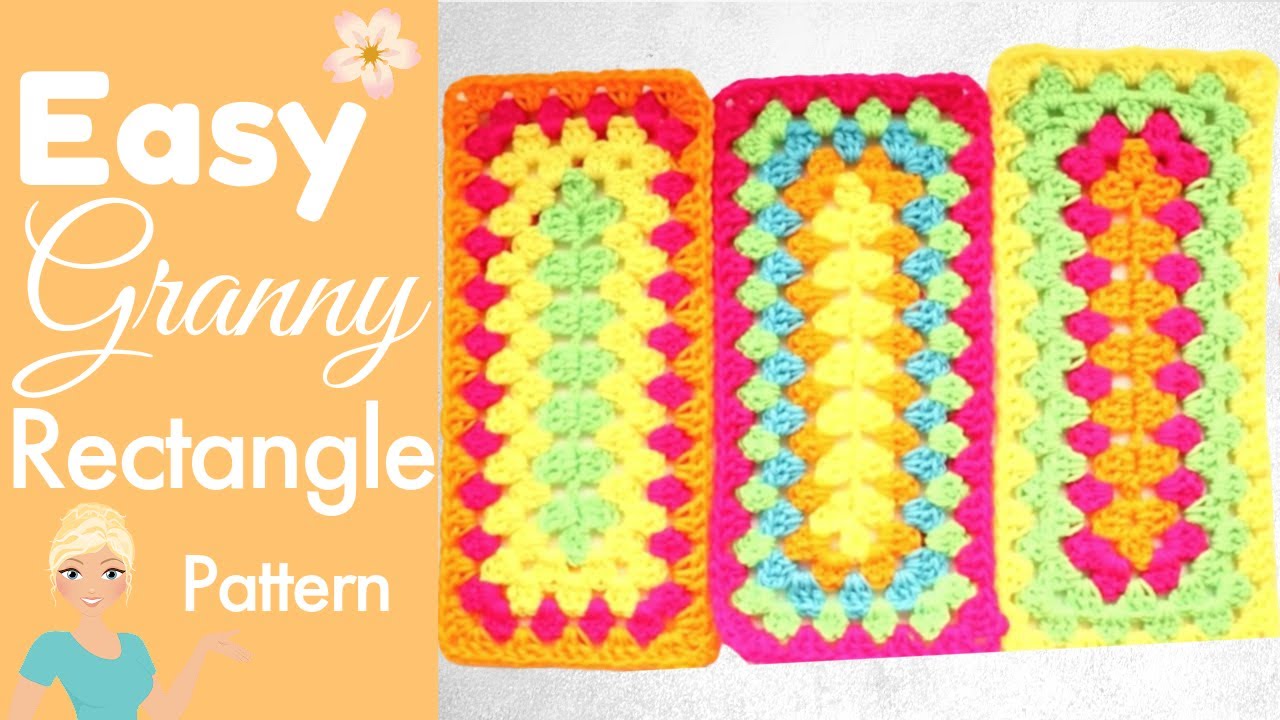
How to Crochet a Granny Rectangle - ELONGATED GRANNY SQUARE
Crocheting granny rectangles that perfectly align with five-round granny squares is easier than you might think. They're versatile, great for mixing with other granny square designs, and work beautifully for the "Toxic Granny Project" or standalone projects like tile-work patterns and parquet designs. They’re also a lifesaver for stash-busting your leftover yarn. Whether you’re using scraps or sticking to a cohesive color scheme, these elongated granny squares bring new life to your crochet projects.
Here's a step-by-step guide to creating stunning granny rectangles. Grab your yarn, and let’s get started!
What You Need to Get Started
To begin, you’ll need the following materials:
- Four-weight worsted acrylic yarn (ideal for this project).
- A 6mm crochet hook.
- Scissors to trim your yarn.
- A yarn needle for weaving in ends.
- Stitch markers or scrap yarn (optional for beginners).
Using scrap yarn is encouraged—start with the smallest bits for the inner rounds, moving to larger amounts as the rows get bigger.
Choosing the Right Tools and Yarn
When picking your yarn, check the label for recommended hook sizes. If no crochet hook size is mentioned but only knitting needles, simply go a size bigger than the needle size listed. For example, a size 5 knitting needle generally translates to a 6mm crochet hook.
Remember, your hook size affects how the final rectangle feels:
- A bigger hook gives you a softer, more flexible rectangle—ideal for cozy blankets.
- A smaller hook results in a firmer, tighter rectangle, perfect for things like pet mats.
For more crochet pattern inspiration, check out the range of Granny Squares available.
Step 1: Starting with the Slip Knot and Foundation Chain
Every crochet project begins with the basics—a slip knot and a foundation chain. Here’s how to start:
- Make a slip knot: Create an "X" on your fingers, pull the back loop through, tighten it, and place it on your hook.
- Chain 24 stitches: Keep your tension light so the chain isn’t too tight. Count carefully to ensure accuracy.
Step 2: Building the First Row
Once your foundation chain is ready, the fun begins! The first row sets the framework for your rectangle.
- Insert your hook into the 4th chain from the hook. This creates the first corner.
- In this same chain, make a "shell" consisting of three double crochets. The first three chains you skipped count as your first double crochet.
- Chain two and repeat these three double crochets in the next designated space.
- Continue this pattern, skipping two chains in between and working into every third chain with three double crochets.
- At the last chain, create a corner by chaining two and placing three additional double crochets.
This method creates the foundation row of your rectangle.
Step 3: Working Along the Other Side
Turning your work is key to forming the rectangular shape.
- Work along the opposite side of your original chain.
- Align your stitches carefully, adding a mirror image of the shells along the other side.
- Make sure to only chain two stitches at the corner points—keep the sides free of unnecessary chains for a clean edge.
For advanced techniques, like avoiding twisting during your project, read Granny Squares & Shapes.
Step 4: Invisible Join for a Seamless Look
To finish the first round, use an invisible join for a polished, professional look. Slip stitch into the top of the starting chain-three, then chain one to secure the yarn.
Cut your yarn, pull it through the loop, and snug it down to secure.

Step 5: Adding New Rounds with Color Changes
Changing colors adds variety and depth to your granny rectangles. Here’s how to do it:
- Flip your work over to the back side (with “macaroni-looking” stitches facing up).
- Choose any corner to attach your new color.
- Leave a 6-inch yarn tail for weaving later.
- Slip stitch to join the new color, chain two, and begin your first corner shell (three double crochets, chain two, three double crochets).
Repeat this process for each side of the rectangle, chaining only at the corners.
For creative color ideas, explore this Color Changing Granny Square Pattern.
Step 6: Flipping for Symmetry
It’s crucial to flip your work over between rounds. This ensures the rectangle doesn’t twist or lose its shape. Flipping also keeps the stitches looking uniform and tidy on both sides.
Step 7: Using Stitch Markers for Easy Joining
If you're new to crochet, stitch markers can help you locate your starting corner. Place a marker in the corner where you’ll join your new round.
Scrap yarn, bobby pins, or even paper clips work fine if you don’t have stitch markers on hand.
Step 8: Expanding to Five Rounds
Continue adding rounds until you reach five complete rounds. By this stage, your granny rectangle will match the dimensions of a five-round granny square, making it easy to pair the two shapes.
To find more beginner-friendly crochet projects, visit Easy Crochet Projects for Beginners.
Finishing Touches: Weaving Ends Like a Pro
Finally, weave in all the loose yarn tails with a yarn needle. Thread your needle, skip the first stitch of the matching color, and weave under two or three stitches. Then reverse direction to secure it fully.
Trim the ends for a neat, finished look.
Creative Ideas for Granny Rectangles
Granny rectangles lend themselves to endless creative opportunities:
- Combine with traditional granny squares for geometric blankets and throws.
- Use them for custom tile-look floor mats or wall hangings.
- Incorporate them into stylish scarves, rugs, or bags.
For even more patterns, check out Written Crochet Patterns.
Conclusion
Granny rectangles are an exciting twist on the classic granny square. They’re simple, versatile, and perfect for projects big and small. Plus, they’re a fantastic way to use up leftover yarn. Whether you’re working on the Toxic Granny Project or crafting a unique heirloom, these rectangles are bound to add character and charm to your crochet creations.
If you’re experimenting with new patterns or want to elevate your granny squares game, don’t forget to explore all the resources awaiting you at the Secret Yarnery. Happy crocheting!
Left Handed?
FAQs
1. What is the difference between a granny square and a granny rectangle?
Granny squares are worked in a square pattern, while granny rectangles are elongated and rectangular. Both follow similar techniques but differ in shape, making rectangles ideal for larger or more versatile designs.
2. How do I make my granny rectangle the same size as my granny square?
To ensure your granny rectangle matches the size of a five-round granny square, follow the pattern for five rounds. Adjust the number of rounds or tension as needed for consistency.
3. Why is flipping the work important between rounds?
Flipping the work after each round keeps the stitches symmetrical and prevents the rectangle from twisting. This ensures a polished and uniform appearance.
4. Can I use other types of yarn for this project?
Yes! While four-weight worsted acrylic yarn is recommended, you can experiment with other types. Just adjust your hook size to match your yarn for the desired flexibility and tightness.
5. What if my rectangle is curling or twisting?
Curling or twisting can happen due to tight tension or skipped stitches. Relax your tension, count your stitches carefully, and flip the work after each round. Blocking your rectangle after completion can also help fix the shape.
6. Can I use granny rectangles in combination with granny squares?
Absolutely! Granny rectangles pair beautifully with granny squares in blankets, bags, and other projects. Align their edges for seamless integration into your designs.
7. How do I change colors without leaving visible joins?
Use the invisible join technique to attach a new color. Start at any corner, leave a tail for weaving in, and crochet your new color seamlessly.
8. What are some creative project ideas for granny rectangles?
Granny rectangles are versatile! Use them for blankets, scarves, rugs, wall hangings, or even bags. Combine them with squares for geometric patterns or parquet-style designs.
9. How do I prevent gaps in my corners?
To avoid gaps, maintain consistent tension and chain only two stitches in each corner. This keeps the pattern tight and the edges clean.
10. Is this beginner-friendly?
Yes! This pattern is straightforward and ideal for beginners. Use stitch markers to stay organized and start with scrap yarn for practice before working on larger projects.
11. How do I take care of my finished granny rectangle project?
Wash projects made with acrylic yarn on a gentle cycle with cold water, then lay flat to dry. Check your yarn's care instructions for specific guidelines.

Christa Patel is a passionate crochet designer, yarn enthusiast, and creator behind the vibrant community at The Secret Yarnery. With years of experience in teaching and crafting, Christa specializes in making crochet accessible and enjoyable for crafters of all levels. Her tutorials and patterns are loved worldwide for their clarity, creativity, and approachable techniques.
Christa's mission is to inspire fellow yarn lovers to explore innovative designs, perfect for crafting personalized heirlooms and practical everyday items. She is also the mind behind projects like the "Toxic Granny Project", blending traditional patterns with modern color twists to create stunning crochet art.
When she isn’t crocheting or experimenting with new patterns, you’ll find Christa sharing tips, ideas, and resources on her website or YouTube channel, empowering others to confidently pick up their hooks and create.
Discover Christa’s full collection of tutorials, patterns, and yarn inspirations at The Secret Yarnery.


